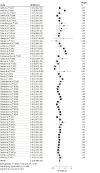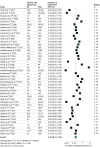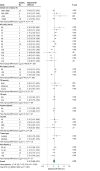Hypotension and Adverse Outcomes in Moderate to Severe Traumatic Brain Injury: A Systematic Review and Meta-Analysis
- PMID: 39527054
- PMCID: PMC11555550
- DOI: 10.1001/jamanetworkopen.2024.44465
Hypotension and Adverse Outcomes in Moderate to Severe Traumatic Brain Injury: A Systematic Review and Meta-Analysis
Abstract
Importance: Traumatic brain injury (TBI) is a leading cause of death and disability worldwide. Hypotension in patients with TBI is associated with poorer outcomes. A comprehensive review examining adverse outcomes of hypotension in patients with TBI is needed.
Objective: To investigate the mortality and incidence of hypotension in patients with TBI.
Data sources: A search of studies published before April 2024 was conducted using MEDLINE, MEDLINE In Process, ePubs, Embase, Classic+Embase, Cochrane Central Register of Controlled Trials, and Cochrane Database of Systematic Reviews for primary research articles in English, including randomized control trials, quasirandomized studies, prospective cohorts, retrospective studies, longitudinal studies, and cross-sectional surveys.
Study selection: Inclusion criteria were patients aged at least 10 years with moderate to severe TBI with hypotension. The exclusion criteria were mild TBI (due to the differences in management principles from moderate to severe TBI). Data were screened using Covidence software with multiple reviewers.
Data extraction and synthesis: This meta-analysis conforms to Preferred Reporting Items for Systematic Reviews and Meta-analyses (PRISMA) and Meta-analysis of Observational Studies in Epidemiology (MOOSE) reporting guidelines for assessing data quality and validity. Primary outcomes (unadjusted and adjusted odds ratios [ORs]) were calculated using a random-effect model with 95% CIs. Incidence of hypotension was derived using logit transformation.
Main outcomes and measures: Main outcomes were association of hypotension with death and/or vegetative state within 6 months and incidence of hypotension. Vegetative state was not reported due to lack of data from included studies. Hypothesis testing occurred before data collection.
Results: The search strategy identified 17 676 unique articles. The final review included 51 studies (384 329 patients). Pooled analysis of found a significant increase in mortality in patients with hypotension and moderate to severe TBI (crude OR, 3.82; 95% CI, 3.04-4.81; P < .001; I2 = 96.98%; adjusted OR, 2.22; 95% CI, 1.96-2.51; P < .001; I2 = 92.21%). The overall hypotension incidence was 18% (95% CI, 12%-26%) (P < .001; I2 = 99.84%).
Conclusions and relevance: This meta-analysis of nearly 400 000 patients with TBI found a significant association of greater than 2-fold odds of mortality in patients with hypotension and TBI. This comprehensive analysis can guide future management recommendations, specifically with respect to blood pressure threshold management to reduce deaths when treating patients with TBI.
Conflict of interest statement
Figures




References
-
- Committee on Accelerating Progress in Traumatic Brain Injury Research and Care, Board on Health Sciences Policy, Board on Health Care Services, Health and Medicine Division, National Academies of Sciences, Engineering, and Medicine ; Berwick D, Bowman K, Matney C, eds. Traumatic Brain Injury: A Roadmap for Accelerating Progress. National Academies Press; 2022. - PubMed
-
- Moorthy DGSRK, Rajesh K, Priya SM, Abhinov T, Devendra Prasad KJ. Prediction of outcome based on trauma and injury severity score, IMPACT and CRASH prognostic models in moderate-to-severe traumatic brain injury in the elderly. Asian J Neurosurg. 2021;16(3):500-506. doi:10.4103/ajns.AJNS_512_20 - DOI - PMC - PubMed
Publication types
MeSH terms
Grants and funding
LinkOut - more resources
Full Text Sources
Medical
Miscellaneous

